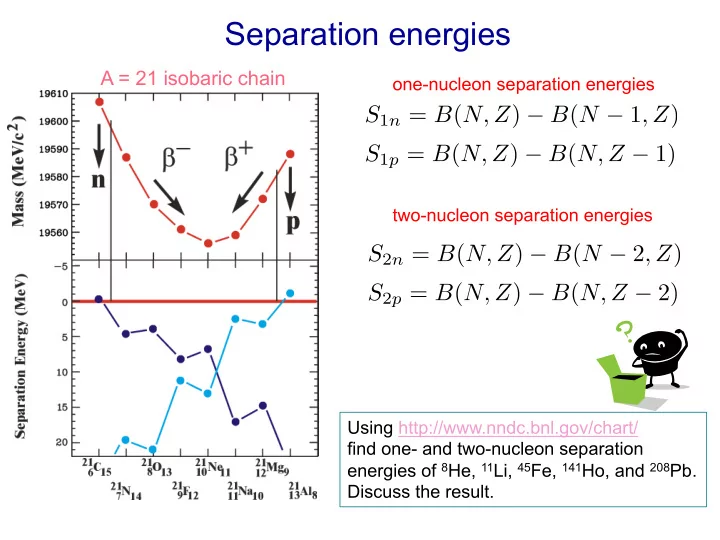

Separation energies A = 21 isobaric chain one-nucleon separation energies two-nucleon separation energies Using http://www.nndc.bnl.gov/chart/ find one- and two-nucleon separation energies of 8 He, 11 Li, 45 Fe, 141 Ho, and 208 Pb. Discuss the result.
Beta decay: energy relations Z Mc 2 = M ' c 2 + Zm e c 2 − ∑ atomic mass B ei i = 1 nuclear ¡mass ¡ electron ¡binding ¡ energy ¡ P(arent) D(aughter) A X N − 1 + e − + ν e a) β - decay A X N → Z + 1 Z ' c 2 − M D ' c 2 − m e c 2 Nuclear ¡recoil ¡is ¡very ¡small ¡ ¡ Q β − = T e − + T ν e = M P In the following, we assume that the neutrino mass is ~zero and that the very small differences in electron binding energy between the parent and daughter atoms can be neglected. This gives: Q β − = M P c 2 − M D c 2 Consequently, ¡the ¡ β -‑ ¡decay ¡process ¡is ¡possible ¡whenever ¡ M P >M D ¡ A X N + 1 + e + + ν e b) β + decay A X N → Z − 1 Z ' c 2 − M D ' c 2 − m e c 2 Q β + = T e + + T ν e = M P = M P c 2 − M D c 2 + 2 m e c 2 ( ) Consequently, ¡the ¡ β + ¡decay ¡process ¡has ¡a ¡ threshold ¡ 2m e c 2 ¡
c) Electron capture Atomic ¡electron ¡is ¡captured ¡by ¡a ¡proton. ¡This ¡process ¡leaves ¡ (inverse beta decay) the ¡atom ¡in ¡an ¡excited ¡state: ¡a ¡vacancy ¡has ¡been ¡created! ¡The ¡ vacancy ¡is ¡quickly ¡filled ¡by ¡producing ¡the ¡characteris:c ¡X-‑ray ¡ A X N + e − → Z − 1 A X N + 1 + ν e cascade ¡ Z Q EC = M P c 2 − M D c 2 − B en ( )
examples … mass relationship in electron capture between the parent and daughter atom energy relations in various beta β + ¡decay ¡can ¡occur ¡when ¡the ¡mass ¡of ¡parent ¡ decay processes atom ¡exceeds ¡that ¡of ¡daughter ¡atom ¡by ¡at ¡ least ¡twice ¡the ¡mass ¡of ¡the ¡electron ¡
Radiocarbon dating half-‑life ¡of ¡5730 ¡years ¡ Radiocarbon ¡da:ng ¡is ¡a ¡radiometric ¡da:ng ¡method ¡that ¡uses ¡ 14 C ¡to ¡determine ¡the ¡age ¡of ¡ carbonaceous ¡materials ¡up ¡to ¡about ¡60,000 ¡years ¡old. ¡The ¡technique ¡was ¡developed ¡by ¡ Libby ¡and ¡his ¡colleagues ¡in ¡1949. ¡In ¡1960, ¡Libby ¡was ¡awarded ¡the ¡Nobel ¡Prize ¡in ¡chemistry ¡ for ¡this ¡work. ¡The ¡level ¡of ¡ 14 C ¡in ¡plants ¡and ¡animals ¡when ¡they ¡die ¡approximately ¡equals ¡ the ¡level ¡of ¡ 14 C ¡in ¡the ¡atmosphere ¡at ¡that ¡:me. ¡However, ¡it ¡decreases ¡thereamer ¡from ¡ radioac:ve ¡decay. ¡ Atmospheric ¡nuclear ¡weapon ¡tests ¡ almost ¡doubled ¡the ¡concentra:on ¡of ¡ 14 C ¡ in ¡the ¡Northern ¡Hemisphere. ¡The ¡date ¡ that ¡the ¡Par:al ¡Test ¡Ban ¡Treaty ¡(PTBT) ¡ went ¡into ¡effect ¡is ¡marked ¡on ¡the ¡graph. ¡
Recommend
More recommend